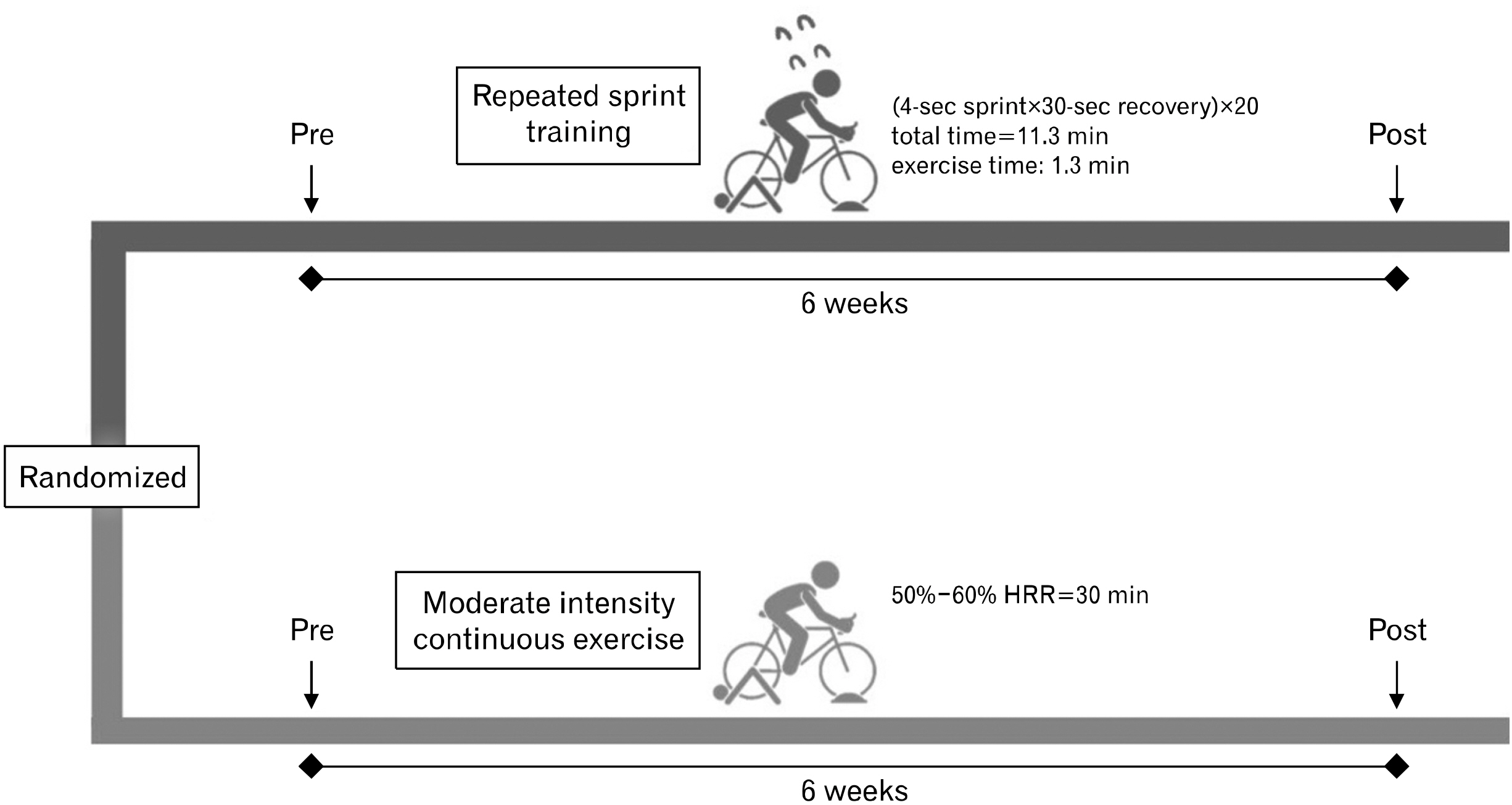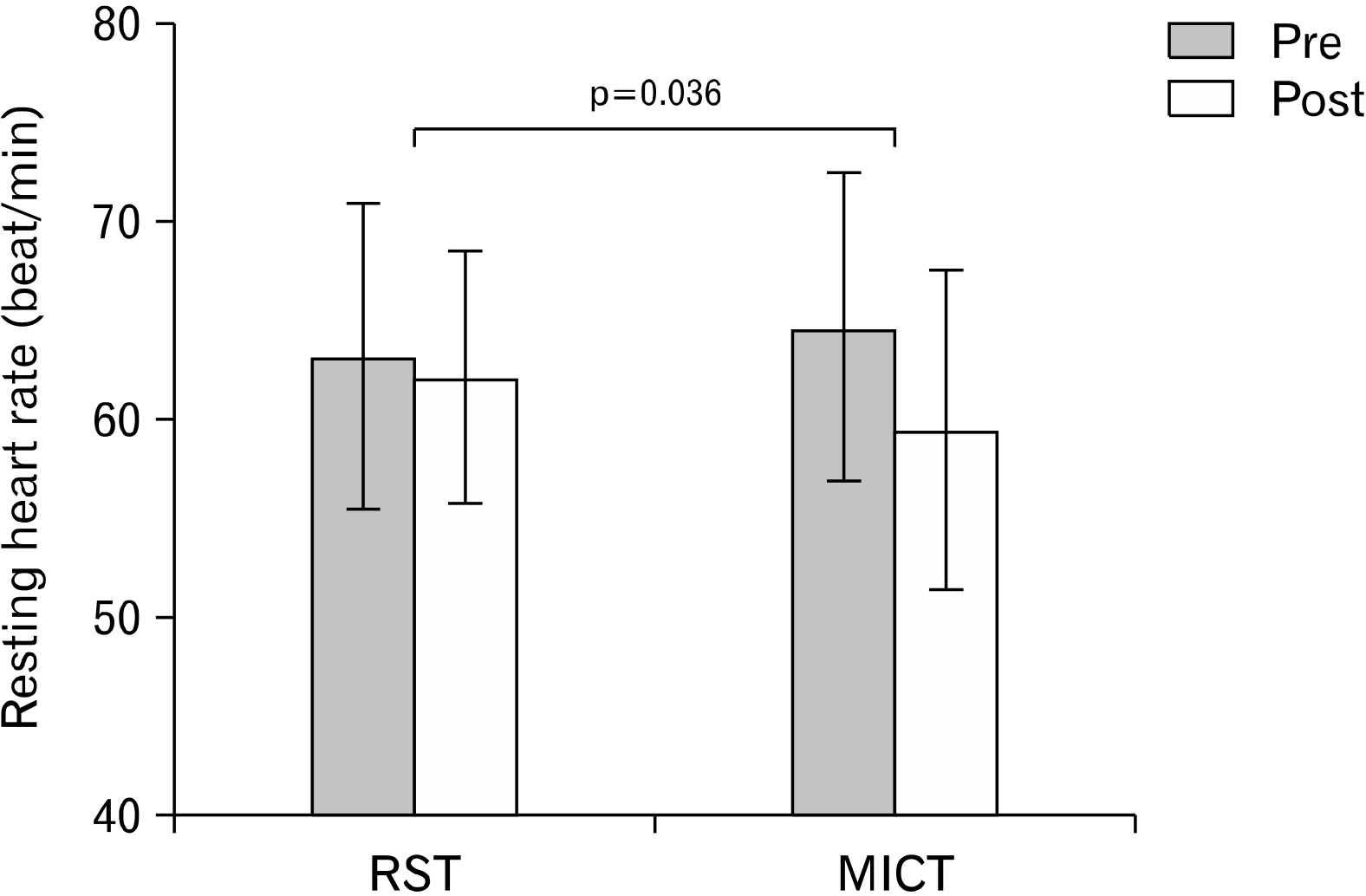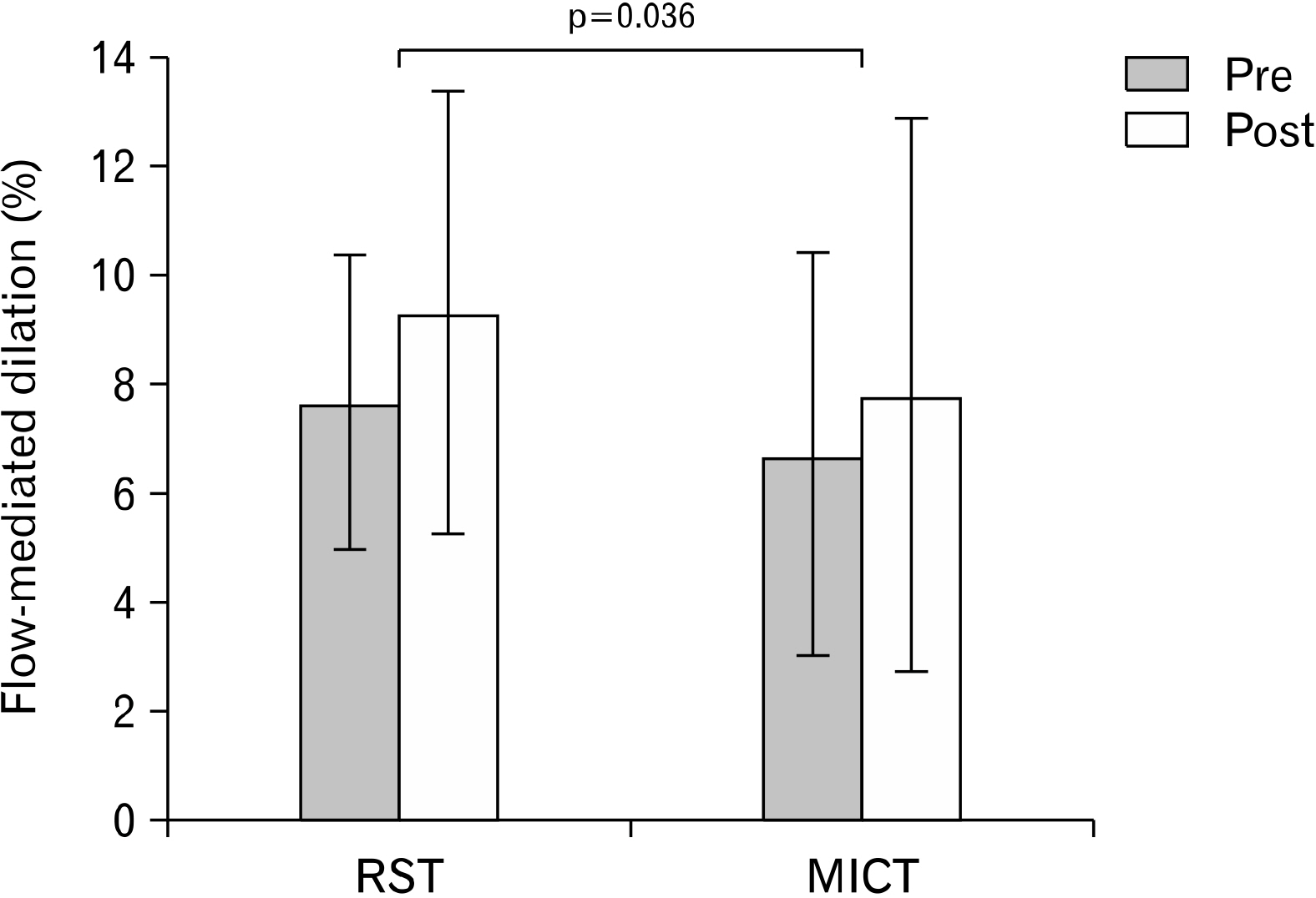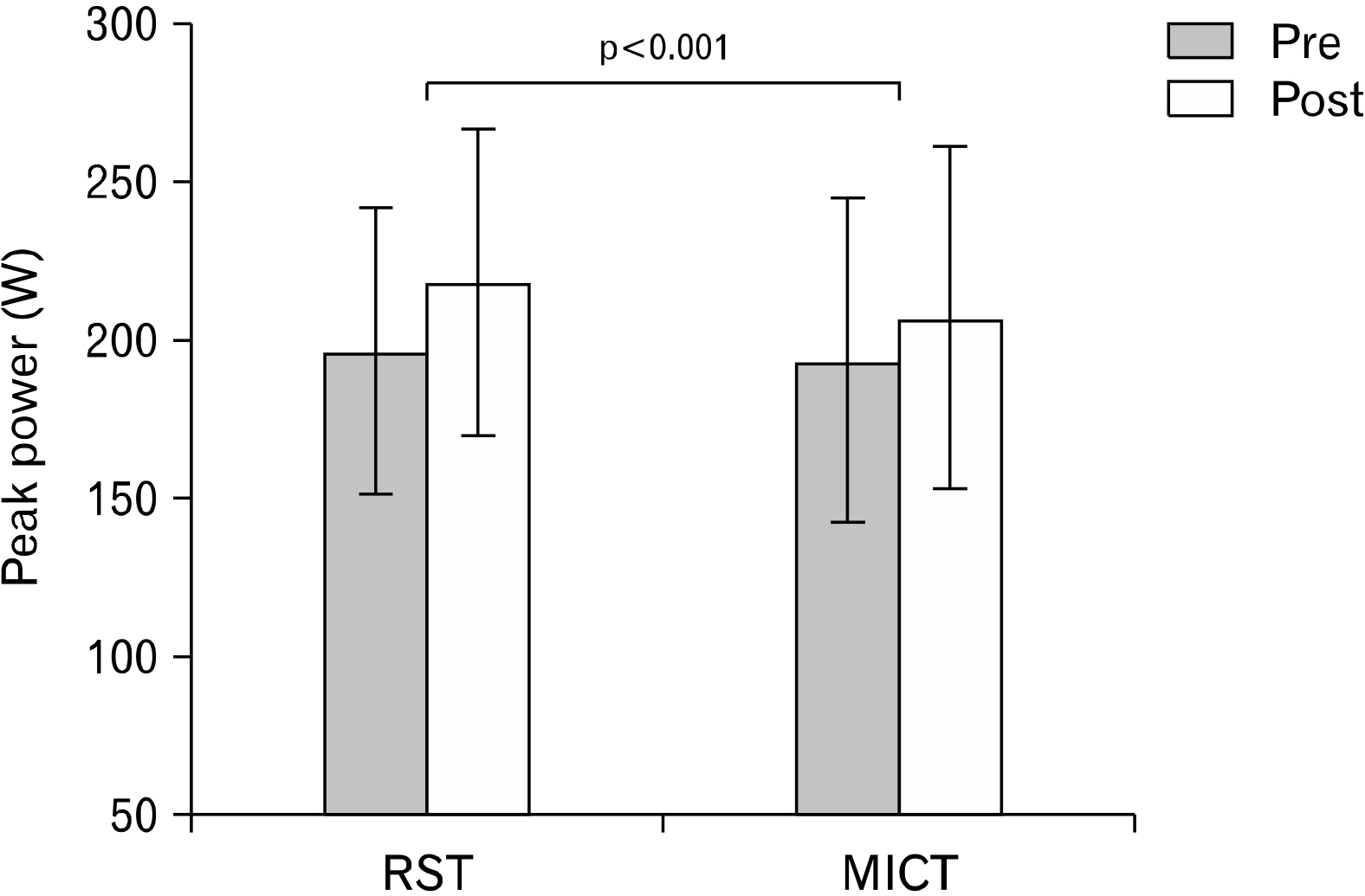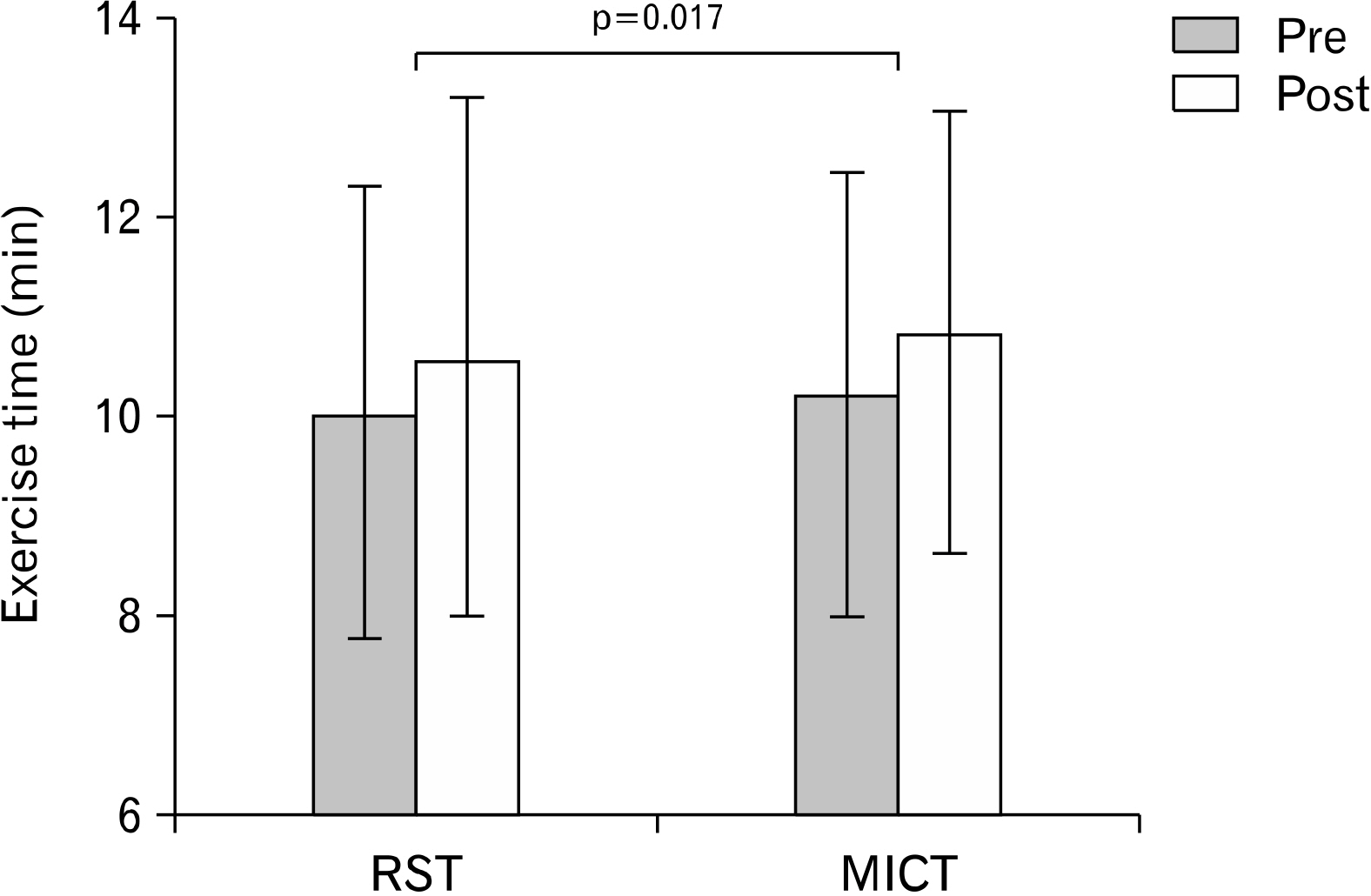Korean J Sports Med.
2024 Jun;42(2):136-144. 10.5763/kjsm.2024.42.2.136.
Effects of Short-term Repeated Sprint Exercise Training and Moderate Intensity Continuous Exercise Training on Vascular Function in Healthy Young Adults
- Affiliations
-
- 1Department of Sport Science, University of Seoul, Seoul, Korea
- 2Division of Urban Social Health, Graduate School of Urban Public Health, University of Seoul, Seoul, Korea
- KMID: 2556279
- DOI: http://doi.org/10.5763/kjsm.2024.42.2.136
Abstract
- Purpose
Moderate-intensity continuous training (MICT) improves exercise capacity with vascular benefits, but time constraints hinder consistent adherence. High-intensity interval training (HIIT) has emerged as a time-efficient alternative, with repeated sprint training (RST) being the shortest format. We hypothesized that RST would be as effective as MICT in improving vascular function and exercise capacity in young adults.
Methods
Twenty-three adults (mean age, 26.2±3.8 years) were randomly assigned to either RST or MICT. RST involved 20 sets of 4-second cycling sprints followed by 30-second active recovery, totaling 11 minutes. MICT consisted of 30-minute cycling at 50% to 60% of heart rate reserve. Vascular function evaluated via brachial artery flow-mediated dilation. Exercise capacity (maximum oxygen uptake, total exercise load test time) and anaerobic capacity (maximum power, anaerobic threshold) were measured using maximum exercise tests. These variables were measured befre and after a 6-week training.
Results
Both groups showed comparable improvements in flow-mediated dilation (p< 0.05). Maximum oxygen intake slightly improved, while total exercise time significantly increased for both (p< 0.05). Anaerobic threshold unchanged, while maximum power improved (p< 0.05).
Conclusion
These findings underscore that RST is a time-efficient exercise strategy, which improves vascular function and exercise capacity as effectively as MICT in young adults.
Figure
Reference
-
1. Piercy KL, Troiano RP, Ballard RM, et al. 2018; The physical activity guidelines for Americans. JAMA. 320:2020–8. DOI: 10.1001/jama.2018.14854. PMID: 30418471. PMCID: PMC9582631.
Article2. Korea Disease Control and Prevention Agency (KDCA). 2022. Korea National Health and Nutrition Examination Survey [Internet]. KDCA;Available from: https://knhanes.kdca.go.kr/knhanes/sub03/sub03_02_05.do. cited 2024 Jan 22.3. Ministry of Culture, Sports and Tourism (MCST), Republic of Korea. 2018. 2017 Survey on participation in sports and exercise for daily life of Koreans [Internet]. MCST;Available from: https://www.mcst.go.kr/kor/s_policy/dept/deptView.jsp?pSeq=1688&pDataCD=0406000000. cited 2024 Jan 22.4. Yin M, Li H, Bai M, et al. 2024; Is low-volume high-intensity interval training a time-efficient strategy to improve cardiometabolic health and body composition? A meta-analysis. Appl Physiol Nutr Metab. 49:273–92. DOI: 10.1139/apnm-2023-0329. PMID: 37939367.
Article5. Buchheit M, Laursen PB. 2013; High-intensity interval training, solutions to the programming puzzle: part I. Cardiopulmonary emphasis. Sports Med. 43:313–38. DOI: 10.1007/s40279-013-0029-x. PMID: 23539308.
Article6. Satiroglu R, Lalande S, Hong S, Nagel MJ, Coyle EF. 2021; Four-second power cycling training increases maximal anaerobic power, peak oxygen consumption, and total blood volume. Med Sci Sports Exerc. 53:2536–42. DOI: 10.1249/MSS.0000000000002748. PMID: 34310498.
Article7. Batacan RB, Duncan MJ, Dalbo VJ, Tucker PS, Fenning AS. 2017; Effects of high-intensity interval training on cardiometabolic health: a systematic review and meta-analysis of intervention studies. Br J Sports Med. 51:494–503. DOI: 10.1136/bjsports-2015-095841. PMID: 27797726.
Article8. Hasegawa N, Fujie S, Horii N, et al. 2018; Effects of different exercise modes on arterial stiffness and nitric oxide synthesis. Med Sci Sports Exerc. 50:1177–85. DOI: 10.1249/MSS.0000000000001567. PMID: 29381650.
Article9. Malin SK, Gilbertson NM, Eichner NZ, Heiston E, Miller S, Weltman A. 2019; Impact of short-term continuous and interval exercise training on endothelial function and glucose metabolism in prediabetes. J Diabetes Res. 2019:4912174. DOI: 10.1155/2019/4912174. PMID: 31976336. PMCID: PMC6954470.
Article10. Herbert P, Sculthorpe N, Baker JS, Grace FM. 2015; Validation of a six second cycle test for the determination of peak power output. Res Sports Med. 23:115–25. DOI: 10.1080/15438627.2015.1005294. PMID: 25720917.
Article11. Karvonen J, Vuorimaa T. 1988; Heart rate and exercise intensity during sports activities. Practical application. Sports Med. 5:303–11. DOI: 10.2165/00007256-198805050-00002. PMID: 3387734.12. Thijssen DH, Bruno RM, van Mil AC, et al. 2019; Expert consensus and evidence-based recommendations for the assessment of flow-mediated dilation in humans. Eur Heart J. 40:2534–47. DOI: 10.1093/eurheartj/ehz350. PMID: 31211361.
Article13. Myers J, Prakash M, Froelicher V, Do D, Partington S, Atwood JE. 2002; Exercise capacity and mortality among men referred for exercise testing. N Engl J Med. 346:793–801. DOI: 10.1056/NEJMoa011858. PMID: 11893790.
Article14. Beaver WL, Wasserman K. 1991; Muscle RQ and lactate accumulation from analysis of the VCO2-VO2 relationship during exercise. Clin J Sports Med. 1:7–34. DOI: 10.1097/00042752-199101000-00004.15. Inaba Y, Chen JA, Bergmann SR. 2010; Prediction of future cardiovascular outcomes by flow-mediated vasodilatation of brachial artery: a meta-analysis. Int J Cardiovasc Imaging. 26:631–40. DOI: 10.1007/s10554-010-9616-1. PMID: 20339920.
Article16. Maeda S, Miyauchi T, Kakiyama T, et al. 2001; Effects of exercise training of 8 weeks and detraining on plasma levels of endothelium-derived factors, endothelin-1 and nitric oxide, in healthy young humans. Life Sci. 69:1005–16. DOI: 10.1016/S0024-3205(01)01192-4. PMID: 11508642.
Article17. Gielen S, Schuler G, Adams V. 2010; Cardiovascular effects of exercise training: molecular mechanisms. Circulation. 122:1221–38. DOI: 10.1161/CIRCULATIONAHA.110.939959. PMID: 20855669.18. Sessa WC, Pritchard K, Seyedi N, Wang J, Hintze TH. 1994; Chronic exercise in dogs increases coronary vascular nitric oxide production and endothelial cell nitric oxide synthase gene expression. Circ Res. 74:349–53. DOI: 10.1161/01.RES.74.2.349. PMID: 7507417.
Article19. Adamson S, Kavaliauskas M, Yamagishi T, Phillips S, Lorimer R, Babraj J. 2019; Extremely short duration sprint interval training improves vascular health in older adults. Sport Sci Health. 15:123–31. DOI: 10.1007/s11332-018-0498-2.
Article20. McDonnell BJ, Maki-Petaja KM, Munnery M, et al. 2013; Habitual exercise and blood pressure: age dependency and underlying mechanisms. Am J Hypertens. 26:334–41. DOI: 10.1093/ajh/hps055. PMID: 23382483.
Article21. Fantin F, Giani A, Zoico E, Rossi AP, Mazzali G, Zamboni M. 2019; Weight loss and hypertension in obese subjects. Nutrients. 11:1667. DOI: 10.3390/nu11071667. PMID: 31330870. PMCID: PMC6682923.
Article22. Kannel WB, Kannel C, Paffenbarger RS, Cupples LA. 1987; Heart rate and cardiovascular mortality: the Framingham Study. Am Heart J. 113:1489–94. DOI: 10.1016/0002-8703(87)90666-1. PMID: 3591616.
Article23. Helgerud J, Høydal K, Wang E, et al. 2007; Aerobic high-intensity intervals improve VO2max more than moderate training. Med Sci Sports Exerc. 39:665–71. DOI: 10.1249/mss.0b013e3180304570. PMID: 17414804.
Article24. Laterza MC, de Matos LD, Trombetta IC, et al. 2007; Exercise training restores baroreflex sensitivity in never-treated hypertensive patients. Hypertension. 49:1298–306. DOI: 10.1161/HYPERTENSIONAHA.106.085548. PMID: 17438307.
Article25. Ramos JS, Dalleck LC, Borrani F, et al. 2017; High-intensity interval training and cardiac autonomic control in individuals with metabolic syndrome: a randomised trial. Int J Cardiol. 245:245–52. DOI: 10.1016/j.ijcard.2017.07.063. PMID: 28747269.
Article26. Dorado C, Sanchis-Moysi J, Calbet JA. 2004; Effects of recovery mode on performance, O2 uptake, and O2 deficit during high-intensity intermittent exercise. Can J Appl Physiol. 29:227–44. DOI: 10.1139/h04-016. PMID: 15199225.27. Belcastro AN, Bonen A. 1975; Lactic acid removal rates during controlled and uncontrolled recovery exercise. J Appl Physiol. 39:932–6. DOI: 10.1152/jappl.1975.39.6.932. PMID: 765313.
Article28. Gleser MA, Vogel JA. 1971; Endurance exercise: effect of work-rest schedules and repeated testing. J Appl Physiol. 31:735–9. DOI: 10.1152/jappl.1971.31.5.735. PMID: 5117189.
Article29. Hickson RC, Bomze HA, Holloszy JO. 1977; Linear increase in aerobic power induced by a strenuous program of endurance exercise. J Appl Physiol Respir Environ Exerc Physiol. 42:372–6. DOI: 10.1152/jappl.1977.42.3.372. PMID: 838658.
Article30. Cooney MT, Vartiainen E, Laatikainen T, Juolevi A, Dudina A, Graham IM. 2010; Elevated resting heart rate is an independent risk factor for cardiovascular disease in healthy men and women. Am Heart J. 159:612–9. DOI: 10.1016/j.ahj.2009.12.029. PMID: 20362720.
Article31. Jakeman J, Adamson S, Babraj J. 2012; Extremely short duration high-intensity training substantially improves endurance performance in triathletes. Appl Physiol Nutr Metab. 37:976–81. DOI: 10.1139/h2012-083. PMID: 22857018.
Article32. Chasiotis D, Sahlin K, Hultman E. 1982; Regulation of glycogenolysis in human muscle at rest and during exercise. J Appl Physiol Respir Environ Exerc Physiol. 53:708–15. DOI: 10.1152/jappl.1982.53.3.708. PMID: 6813302.
Article33. MacDougall JD, Hicks AL, MacDonald JR, McKelvie RS, Green HJ, Smith KM. 1998; Muscle performance and enzymatic adaptations to sprint interval training. J Appl Physiol (1985). 84:2138–42. DOI: 10.1152/jappl.1998.84.6.2138. PMID: 9609810.
- Full Text Links
- Actions
-
Cited
- CITED
-
- Close
- Share
- Similar articles
-
- Comparison of Effects of Acute Tabata-Styled and Moderate Intensity Continuous Exercise on Vascular Function in Healthy Young Men
- Effects of a Single Bout of High-Intensity Interval Training and Moderate-Intensity Continuous Training on Blood Glucose Homeostasis and Exosome in Young Adults
- Interaction of genetic background and exercise training intensity on endothelial function in mouse aorta
- An Overview of Current Physical Activity Recommendations in Primary Care
- The Effect of Sprint and Heavy Resistance Training on Muscle Strength, Endurance and Muscle Fiber Type

